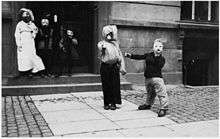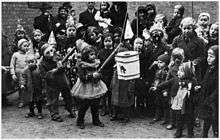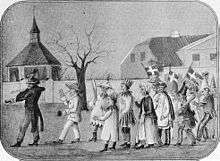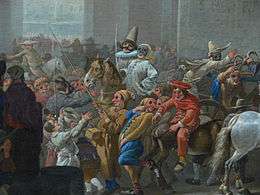Fastelavn
Fastelavn[1] is a Carnival tradition in the Northern European, and historically Lutheran, nations of Denmark, Norway, Sweden, Iceland and the Faroe Islands.[2] The related word Fastelovend is used for Carnival in Germany in Köln and Bonn with the same meaning. Fastelavn is related to the Roman Catholic tradition of Carnival in the days before Lent, although after Denmark became a Protestant nation the festival adopted certain distinctive characteristics. The holiday occurs the week before the Christian penitential season of Lent, culminating on Shrove Tuesday, the day before Ash Wednesday, the first day of Lent.[3] The Swedish counterpart is Fettisdagen, the Icelandic is Öskudagur, and in Finland they celebrate Laskiainen. In Iceland, Ísafjörður is the only town that celebrates Fastelavn on the same day as the other Nordic countries. The day is known as Maskadagur (mask-day).
The traditions of Fastelavn vary somewhat between the countries, and local regions, and some traditions have changed over time. A common theme of Fastelavn in all the countries currently involves children dressing up in costumes, walking door to door while they sing and gathering treats for the Fastelavn feast, a form of trick-or-treat. Today, the festivities of Fastelavn are generally considered to be a time for children's fun and family games.
Etymology
The term Fastelavn comes from Old Danish fastelaghen, which was a borrowing of the Middle Low German vastel-avent, meaning "fast-evening", or the day before Lent.[4] The word has cognates in other mostly Germanic languages and languages with contact with it, including Kölsch Fastelovend, Limburgish Vastelaovend, Dutch Vastenavond, Scots Fastens-een, Latvian Vastlāvji, and Estonian Vastlapäev.
Festivities

As in Carnival traditions elsewhere, dressing up in costumes forms an important part of Fastelavn in all the Nordic Lutheran countries where this festivity is celebrated. In some places this involves smaller processions, but in contrast to former times, dressing up in costumes are now mainly a children's activity only.
In Norway, students having seen celebrations in Paris introduced Carnival processions, masked balls and Carnival balls to Christiana in the 1840s and 1850s. From 1863, the artist federation kunstnerforeningen held annual Carnival balls in the old freemasons lodge, which inspired Johan Svendsen's compositions "Norsk Kunstnerkarneval" and "Karneval in Paris". The following year, Svendsens Festpolonaise was written for the opening procession of the Carnival ball. Edvard Grieg also attended the Carnival, and wrote "aus dem Karneval" (folkelivsbilleder Op. 19). After the Rococo Hall at Grand Hotel opened in 1894, annual balls in the Carnival season were arranged until the hall was destroyed in a fire in 1957. Since 1988, the student organization Tårnseilerne have produced annual masquerade balls in Oslo in the historical renovated freemasons lodge in the Carnival tradition, with masks, costumes and processions after attending an opera performance. The Carnival season also includes Fastelavens søndag (with cream buns) and fastelavensris with decorated branches.
Cat in a barrel

Traditional events include slå katten af tønden ("hit the cat out of the barrel"), which is somewhat similar to using a piñata. The Danes use a wooden barrel, which is full of candy and sometimes oranges and has the image of a cat on it. After the candy pours out, the game continues until the entire barrel is broken. The one who knocks down the bottom of the barrel (making all the candy spill out) becomes kattedronning ("queen of cats"); the one who knocks down the last piece of the barrel becomes kattekonge ("king of cats").[5]
In Denmark, the barrel tradition has been practised for centuries, possibly introduced by Dutch immigrants to Copenhagen during the reign of Christian II of Denmark in the early 1500s. Historically, there was a real cat in the barrel, and beating the barrel was superstitiously considered a safeguard against evil. It was practised up until the 1800s, with the last known event occurring in the 1880s. The cat was not killed, but allowed to escape when the barrel was broken. The practise also used to be popular in Holland and similar events were known from Germany, called "Katzenschlagen".[6]
Songs
A popular children's song in Denmark is:
|
|
_(ubt).svg.png) Fastelavn song
|
The song is sung on various occasions related to Fastelavn, but mostly by costumed children, walking door to door, as a form of trick-or-treat. Even though the song relates to Fastelavnsboller, candy or money is usually offered to the kids when they sing.
Cakes
.jpeg)
In Denmark and Norway a popular baked good associated with Fastelavn is the fastelavnsbolle (lit. "Fastelavn bun", also known in English as "shrovetide bun" or "lenten bun"), a round sweet roll of various sorts usually covered with icing and sometimes filled with a whipped cream mix or pastry cream. In most bakeries they are up for sale throughout the whole month of February.
Similar buns are eaten in other Northern European countries, for example the Swedish Semla.
There seem to be some small local traditions which are closer to the carnival traditions of other countries, including Ash Wednesday, Carnival parades, Pancake Tuesday and eating special food after Ash Wednesday, but they are not particular to Danish culture.
Fastelavnsris
.jpg)
Another popular custom (especially among the children) is the "fastelavnsris", with which children ritually flog their parents to wake them up on the morning of Fastelavns Sunday (Quinquagesima).
Fastelavnsris have many shapes and forms and differ from area to area. In some areas they are bunches of twigs, usually from fruit trees and preferably with buds. Those are often decorated with feathers, egg-shells, storks and little figures of babies. In other areas, they are a bent willow-branch, shaped like an ankh and wound with crepe paper that has frizzles cut with scissors. Both varieties may be decorated with candy as well.
The custom was known in 18th century in Germany and it has several roots. It may originate from an old pagan fertility ritual, which has been absorbed into Christianity. The more serious one is that after the reformation, particularly pious people used to flog their children on Good Friday to remind them of the sufferings of Christ on the cross. A similar custom is mentioned in the book "Frauenzimmerlexicon", published in 1715 in Leipzig (Germany), which describes how bachelors and virgins "bid each other goodmorning" by flogging each other and spreading ashes on each other. This custom is also known in both Denmark and Norway.
Earlier, it was mainly the young women and the infertile who were flogged. It was also common that a young man would carry his "fastelavnsris" and gently strike at young women he met on the street. Later it became the children's special right to flog their parents on this day. In any case, the reward given for the flogging would be a fastelavnsbolle.
Processions

Fastelavn processions are not practised on any notable scale anymore, but used to form an important part of the festivities for centuries in Denmark. Unmarried adults dressed up in costumes and visited houses of their choice across town. Here they teased, danced and gathered food and money for the Fastelavn celebration. If married people and the elderly wanted to take part in the festivities, they could put on costumes and visit friends to tease and have fun. These costume games were not liked by the Church and the authorities, and were outlawed in 1683; Brorson even wrote a psalm about abolishing the sinful Fastelavn. However, the costume games were popular among the common people and they continued to be practised nonetheless.[7] Today, groups of costumed children walk from door to door to sing and collect candy and small-change money.[8]
In Denmark, special boat processions were practised in coastal communities from at least the early 1700s and consisted of a regular wooden boat with wheels pushed through the streets accompanied by shouts and music. The boat was decorated, sometimes with mythological figures, and when it stopped on its route through town, onlookers were expected to feed a collection box for charity. The last boat processions died out in the 1970s.[9]
References
- Danish pronunciation: [fæstəˈlɑwˀn]
- "Customs behind the buns on Fastelavnsdag". The Foreigner. Norway. Archived from the original on 26 February 2017. Retrieved 26 April 2019.
- Ruprecht, Tony (14 December 2010). Toronto's Many Faces. Dundurn. p. 115. ISBN 9781459718043.
Fastelavn, held the week before Lent, is the Danish Mardi Gras. This even takes place at the Danish Lutheran Church and at Sunset Villa.
- "Fastelavn", Ordbog over det danske sprog, 1922.
- Lars Vedsted (19 February 2007). "Borgerne bryder normerne i skolegården" (in Danish). NordJyske.
- "Hvordan slog man katten af tønden? [Why was "hitting the cat out of the barrel" practised?]" (in Danish). Dansk Historisk Fællesråd.
- "Forbud mod fastelavn [Prohibition on Fastelavn]" (in Danish). Dansk Historisk Fællesråd.
- "Fastelavnsoptog og lege [Fastelavn processions and games]" (in Danish). Dansk Historisk Fællesråd.
- "Fastelavnsbåde og bådeoptog [Fastelavn-boats and boat processions]" (in Danish). Dansk Historisk Fællesråd.
External links
| Wikimedia Commons has media related to Fastelavn. |
- Karneval eller Fastelavn?
- "20 recipes for Fastelavnsboller" (in Danish). ALT.dk.
